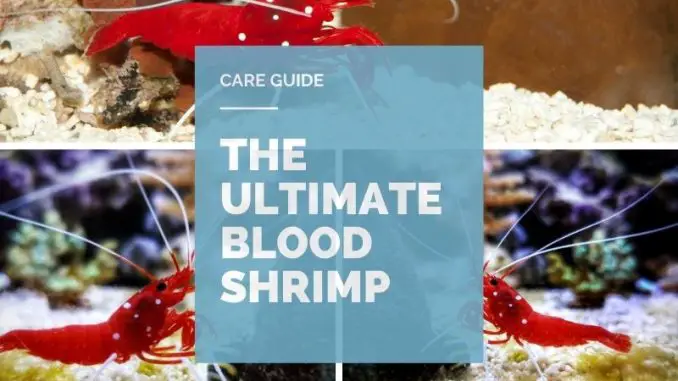
Saltwater shrimps are an excellent way to add some new and interesting behaviors to your aquarium. Many species are extremely colorful and will give your fish a run for their money.
Blood shrimps are one such species. Their bright red colors will liven up the lower regions of your tank. They are a nocturnal species that can be fun to spot when they emerge for food.
They will scavenge for food on their own, taking care of themselves. This makes them very easy to look after, they’re a perfect match for beginners.
We will discuss all the information you need when adding Blood Shrimps to your marine setup, including their ideal setup, their diet, how to breed them, and much more…
TABLE OF CONTENTS
Blood Shrimp Care Facts & Overview
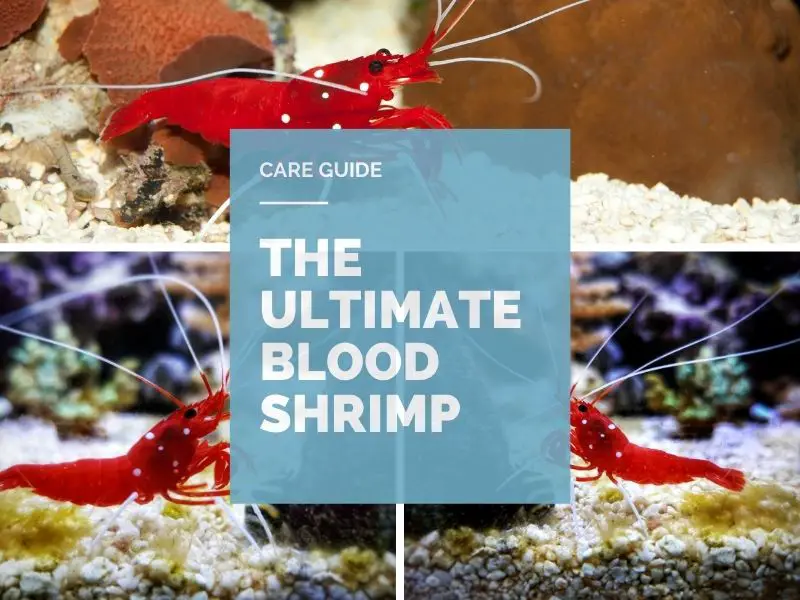
| Category | Rating |
| Care Level: | Easy |
| Temperament: | Peaceful towards other species |
| Color Form: | Red with white spots |
| Lifespan: | Up to 2 years |
| Size: | Up to 2 inches |
| Diet: | Omnivore |
| Family: | Hippolytidae |
| Minimum Tank Size: | 10 gallons |
| Tank Set-Up: | Saltwater reef |
| Compatibility: | Peaceful community |
Shrimps are often overlooked when designing an aquarium. Many aquarists are missing out on the services and unique behaviors they offer.
Blood shrimps are a popular saltwater species. They are known by a few other names, such as fire shrimp, blood red shrimp, scarlet cleaner shrimp, and Lysmata debelius (their scientific name).
They are members of the Hippolytidae family, which are often referred to as the anemone shrimp.
Blood Shrimps are an example of a cleaner shrimp, which removes parasites from fish. This is a symbiotic relationship; the shrimps eat the parasites as food and the fish are free of disease.
This is one way that Blood Shrimps help to maintain a healthier environment.
The species is native to the Indo-Pacific where they live in reef ecosystems. They enjoy the tropical conditions here and utilize the nooks and crannies created by the corals as shelter.
In an aquarium, their needs are simple. They mostly take care of themselves, so they are a great choice for an aquarist starting a marine setup for the first time.
As a favorite in the aquarium trade, Blood Shrimps are commonly sold, so you shouldn’t have to travel far to find some.
They can be quite expensive for such a small creature. Each shrimp will set you back $20-$30.
Before purchasing, check the health of the stock in the shop. If you notice any signs of injury or disease, shop elsewhere.
A healthy individual can live for up to 2 years, but this could stretch even further in a pristine environment with a nutritious diet.
Typical Behavior
Generally, this is a shy species that keeps to itself most of the time.
The only aggression they show is directed at other Blood Shrimps, though sometimes aggression is extended towards other cleaner shrimps too.
For this reason, one per tank is recommended.
Cleaner shrimps are usually ignored by fish because of the services they provide, but there is no guarantee that large fish won’t try to eat them.
There are some reports of Blood Shrimp damaging coral polyps, but the species is generally considered reef safe. Bear this in mind if you have lots of expensive corals though.
They are most active at night, coming out in search of food.
However, this nocturnal species will learn your feeding routine and will emerge to ensure that they get some food before everyone else.
Some people report that their Blood Shrimp recognizes them. Some will even learn to accept food from an owner’s hand.
One more behavior to be aware of is molting. This is where a shrimp discards their old exoskeleton so that a new, larger, and stronger one can develop. This is more frequent for younger individuals.
The discarded exoskeleton can look like a dead shrimp, so don’t be tricked into assuming the worst.
Appearance

Shrimps really stand out in an aquarium. They look vastly different from fish and contrast them well. This paired with their unique behaviors creates an attractive addition to your tank.
Blood Shrimps are one of the brightest and most beautiful saltwater species, which is one reason why they are so popular.
Their body is a vibrant red with a few white spots on the carapace. The red spreads halfway down their legs and partly along with their antennae.
Sometimes they will look a bit pale. If this is due to stress or illness, their color will return as they recover.
They will be paler after molting too, but their exoskeleton will darken as it hardens.
Their body will reach a size of 1.5-2 inches, but they can take up a lot more space due to their antennae, which could be as long as the body. These are used to feel and “taste” their environment.
As a decapod crustacean, they also have ten legs attached to their thorax.
Behind the carapace is an abdomen made up of six segments. Having many segments enables them to curl up their body. A small, fan-like tail is attached to the sixth segment.
On the first five segments are pairs of swimming appendages called pleopods. These are slightly paddle-shaped to help them move through the water.
Blood Shrimps are hermaphrodites – they have both male and female reproductive organs so any two individuals can mate together. This means that sexing them is unnecessary.
Overall, this species has stereotypical shrimp body shape. It’s their red color that draws people in and tempts them to add one to their aquarium.
Habitat and Tank Conditions

You would naturally find Blood Shrimps in the Indo-Pacific. They populate reef environments around places like Sri Lanka, the Ryukyu Islands, the Philippines, and Indonesia.
Reef habitats have plenty of caves for shrimps to use as shelter; they will choose a cave and return there regularly. Corals provide plenty of surfaces for them to climb over and between.
Coral reefs in tropical areas, so the water would be warm and alkaline, and there would be plenty of sunlight coming from above.
Blood Shrimps live where they do in the wild because the conditions are perfect for them. Therefore, you should be trying to recreate this environment in your aquarium.
This is simple to do, we will outline the how-to below.
Tank Conditions
Choose a fine-grained substrate to coat the bottom of the aquarium. A soft substrate is important so that it doesn’t damage a shrimp’s sensitive antennae as they move around.
On top of the substrate add some decorations. Live rock is a good choice or, if you can afford them, you could add some corals.
Blood Shrimps will enjoy having things to climb over since they spend all their time at the bottom of the tank.
Maintaining their preferred water conditions is important for keeping your shrimps healthy.
Use a heater to keep the water between 75°F and 82°F. The pH should be 8.1-8.4 and salinity of 1.023-1.025 is crucial.
Standard aquarium lighting is fine, so the only other equipment you’ll need is a filter. You can use an air pump to help circulate the water if your filter isn’t strong enough.
Using dimmer lights may encourage this nocturnal species to be more active during the day.
What Size Aquarium do they need?
Blood Shrimps do not grow larger than 2 inches, so they can fit into small aquariums. A 10-gallon tank is a minimum, but they would prefer a larger tank where they are free to explore a bit more.
The more space you can provide, the happier they will be.
Though larger tanks are more expensive and take up more space, they are easier to maintain, particularly in terms of water conditions. This will help you to keep all the inhabitants healthy.
How Many Can be kept per gallon?
You should only be one Blood Shrimp per tank, the size of your aquarium doesn’t matter (unless it is extremely large).
Blood Shrimps will fight each other and similar cleaner shrimps, so they need to be kept separately. They are fine with fish though.
Tank Mates
This makes it a great choice for a community aquarium. Though they live a mostly solitary lifestyle, Blood Shrimps would be around lots of other creatures in the wild.
As cleaner shrimp, they interact with fish when removing parasites.
Most fish appreciate the cleaning service and therefore won’t try to eat Blood Shrimps, but you never know what a hungry fish will do.
To ensure their safety, pick tankmates carefully. Aggression isn’t usually a problem; Blood Shrimps won’t attack fish and most fish will ignore them.
Large fish can be a worry though. If they are large enough to eat Blood Shrimp, they may view them as snacks. Stick to smaller fish species in your aquarium.
The Blue Hippo Tang makes a good tank mate because it is particularly susceptible to parasites, so it can really benefit from being around a cleaner shrimp.
Other invertebrates can be kept alongside Blood Shrimps. The only exceptions are other cleaner shrimps. Keep one cleaner shrimp (including Blood Shrimp) per tank to avoid fighting.
There are some reports of Blood Shrimps damaging corals, but Blood Shrimps are generally considered reef safe.
Can You Keep Blood Shrimps Together?
No. While Blood Shrimps are peaceful towards fish and most other invertebrates, they will attack each other and similar species.
This fighting may not be fatal, but you should eliminate any risk that it could be. Only keep one Blood Shrimp per tank.
You should only keep multiple shrimp for breeding purposes or if you have an exceptionally large tank where they can avoid each other most of the time.
Diet
These shrimps aren’t fussy when it comes to feeding. They are natural scavengers that spend a lot of their time looking for food.
In the wild, this could be the meaty remains of anything that has fallen to the substrate, or it could be dead pieces of vegetation. They would eat parasites or dead skin from fish too.
All of these foods can be supplied in an aquarium. The most basic examples are dried foods (flakes and pellets). These are cheap and convenient but they’re not very nutritious.
Better choices would be frozen foods, which retain most of their nutrients. There are many kinds of frozen foods in pet stores, these creatures will be happy with any of them.
Blood Shrimps are able to learn feeding routines. They will emerge when they are expecting food and become more active. If they trust you, they’ll even accept food from your hand.
It is easy for fish to steal food as it falls through the water, so make sure that some are reaching the substrate for your shrimps. Sometimes target feeding is the best way to get food to your shrimp.
They don’t need to be given much at feeding times, as it will be supplementary to their scavenging. They will clear up the food that your fish haven’t eaten as the main component of their diet.
Since they are nocturnal, they do most of their scavenging at night when the lights are off, so you will probably miss it.
Care
Blood Shrimps are easy to care for. They are a good introduction to marine fish keeping for beginners.
They take care of themselves most of the time, you just need to keep their environment clean and feed them a nutritious diet.
Cleaning will require regular partial water changes and the removal of algae.
Use a water testing kit each week to check that the water parameters are at safe levels. This means you can spot any issue quickly.
It is much easier to maintain water conditions in a larger aquarium.
Blood Shrimps are quite hardy. There are a few diseases that they can pick up, but they are rare. They are more likely to treat disease by eating parasites than becoming ill themselves.
Molting will occur occasionally so that your shrimp can develop a larger and stronger exoskeleton. The discarded casing can look like a dead shrimp; it’s easy to be fooled.
Remove the old exoskeleton before it can be broken down to lower the quality of your water.
Keep a closer eye on your Blood Shrimp when you spot that they are molting. They are particularly vulnerable to damage until their new carapace hardens.
They will hide away safely until they are strong enough to protect themselves. Don’t move them until they are out and about again, or else you may damage them yourself.
Whenever you are adding something to your aquarium water, check whether it contains copper. Copper is toxic to invertebrates and will quickly lead to death.
Medications commonly contain copper, as it is effective at killing parasites, so be careful when treating your shrimp or any fish in their community.
Breeding

Breeding Blood Shrimps can be tricky, but there are plenty of success stories, both in-home aquariums, and commercial settings.
As hermaphrodites, each individual has both sets of reproductive organs. Any two Blood Shrimps that you buy will be able to mate together.
This is one less thing to think about. Identifying males and females to ensure you have a mating pair can be difficult with certain species.
Though Blood Shrimps display aggression towards members of their own species, this is usually reduced between a mating pair.
For a pair to start mating, they will need a perfect environment. It must be clean, and the water must be maintained with their preferred conditions.
A nutritious diet is important too, giving them the energy needed for breeding.
Hopefully, spawning should start without intervention from you. If not, gradually raise the temperature to 82°F.
After spawning, eggs will be spread throughout the tank. Blood Shrimps have no parental instincts, so remove them from the tank to protect the eggs. They will take about 2 weeks to hatch.
Raising the larvae can be difficult because they are incredibly delicate. They can easily be drawn into the filter inlet, so use a sponge filter.
Over the course of roughly 90 days, they will regularly molt and progress through six larval stages.
Their diet will need to change as they grow. Initially feed them diatoms, brine shrimp eggs, microalgae, and rotifers.
After 5 days, you could include newly hatched brine shrimp nauplii. After 13 days, you can add puree cuttlefish and live copepods.
These foods will be suitable until they metamorphize into juveniles, reaching about 0.4 inches.
Don’t expect all the larvae to survive, only 10%-20% will.
Are Blood Shrimps Suitable for Your Aquarium?
A marine aquarium isn’t quite the same without a saltwater shrimp in it. Their colors and behaviors are very entertaining.
Blood Shrimps are one of the most popular species. You will understand why the moment you see them. Their bright red body with white spots is incredibly attractive.
They can be added to many different setups, just make sure that you don’t have any fish that are big enough to eat them. You can’t have any other cleaner shrimp either.
They may be nocturnal, but this beautiful species will still add plenty of wonder to your aquarium. They are very easy to care for too, so everyone can enjoy them.
Why do you like Blood Shrimps? Let us know in the comments below…

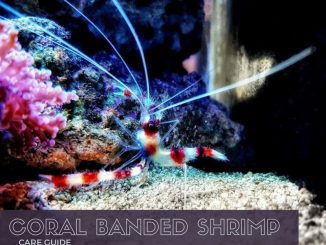
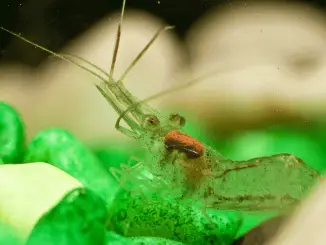
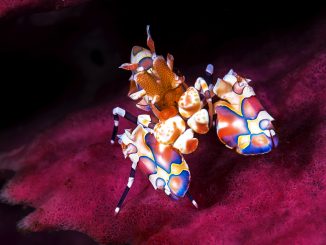
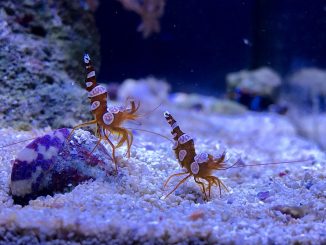
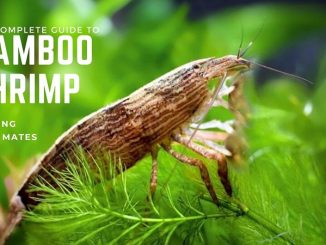
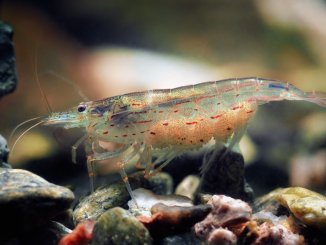
Be the first to comment